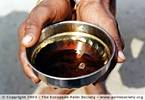 Khéjur-gur
Khéjur-gur
(page 3)


During the summer, night temperatures are high and
sap harvested ferments by morning, rendering the product fit only
as an alcoholic drink. The sap during summer is also not as sweet.
Therefore, the sap from Phoenix sylvestris trees is tapped only
during winter, from around November until late February. The sap
during this cold season is sweetest and does not ferment quickly
due to the mild climate.
There is no organized Phoenix sylvestris farm or
plantation. The seeds that the plants bear drop down and germinate,
where goats like to nibble them. Some seeds settle in the thickets
that surround the base of mature trees, where the goats cannot reach
them, and thus can continue to grow. These become future providers
of sap. Anand said he just gets a “feel” when a tree is
mature enough for first harvest. We saw trees with a clear stem
of about 6 ft. that had two or three notches on the trunk indicating
they had been harvested over the last couple of years. The whole
process of harvesting sap from Phoenix sylvestris is told in eloquent
detail in the book The Palms of British India and Ceylon by E. B.
Blatter, published in 1926 (?). The book is a compilation of papers
published in the Journal of the Bombay Natural History Society by
the author during the period 1910 to 1918. I would like to quote
a portion from the book:
“When the tree is ripe the process of tapping
begins, and it is continued each year thereafter. There are in the
Date-palm two series or stories as it were, of leaves; the crown
leaves, which rise straight out from the top of the trunk; being
so to speak, a continuation of it; and lateral leaves, which spring
out of the side of the top part of the trunk. When the rainy season
has completely passed, and there is no further fear of rain, the
cultivator cuts off the lateral leaves for one half of the circumference,
and thus leaves bare a surface measuring about 10 or 12 inches each
way. This surface is at first a brilliant white, but becomes by
exposure quite brown, and puts on the appearance of coarse matting.
The surface thus laid bare is not the woody fiber of the tree, but
is a bark formed of many thin layers, and it is these layers which
thus change their colour and texture.
continued on [next
page] [previous
page] [top]
[index]
|
 |
[an error occurred while processing the directive] |
